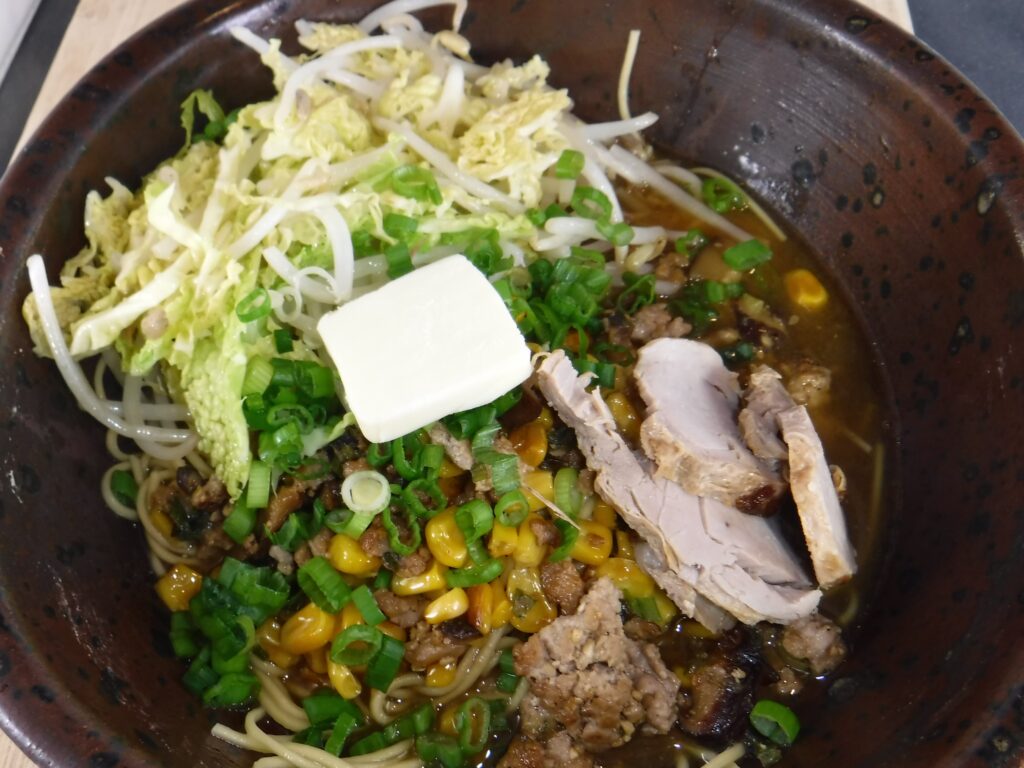
This post will be more of a commentary and memorialization of a recipe rather than the recipe itself. I recently bought Tim Anderson’s Tokyo Stories which is about the wide range of Japanese foods available in contemporary Tokyo, and I picked this dish to try because it was an example of the breadth of styles of ramen, and had the unusual feature of using corn.
Good quality ramen is not that hard, but it is the sort of food which is easier for restaurants than for home cooks because of the multiple components – a good meat and dashi based broth, noodles, and a variety of toppings. A restaurant can deliver a steaming bowl of ramen in about 5 minutes since everything except the noodles has been prepped before the customer arrives. A home cook has to prep all these items for one meal, which is a lot more work.
The broth I made was based on the shoyu ramen broth on page 87, modified to fit the ingredients I had available. This is intended to be 4 servings.
8 cups water
1 Tbs. oil
1-1/2 lbs. chicken feet
14 oz. thinly sliced pork (Kroger was giving this away for $0.99)
1 onion, peeled and quartered
4 cloves garlic
2 inch piece of ginger, thickly sliced
1 tsp. hon dashi
½ oz. dried mushrooms
80 g. cup red miso
I preheated the oven to 250 degrees. I sautéed the chicken feet and pork in the oil in a Dutch oven, until browned. Then I added the water, onion, garlic, and ginger. I deglazed the bottom of the pan, brought it to a boil and reduced to a simmer and cooked it for 30 minutes, skimming off the scum which developed. After 30 minutes, I put a lid on the Dutch oven and put it in the oven for 5 hours. I then strained the broth into an 8 cup pyrex contained, threw out the solids, and added the hon dashi to the broth. I covered the broth with plastic wrap, cooled it on the counter, and then in the refrigerator overnight.
The next day, I skimmed the fat off the top of the broth, which was solid from the gelatin in the chicken feet. I put the defatted broth into a pot with the dried mushrooms and the miso. I brought the broth up to a simmer for 10 minutes and then removed the mushrooms, which were chopped and added later to the ramen topping. At this stage, the broth was quite flavorful, but possibly underseasoned. I left that alone since ramen broth is sometimes too salty.
The main topping was a scallion, pork, mushroom, and miso combination. This is intended to be 4 servings:
2 Tbs. oil (plus more if needed)
4 cloves garlic, sliced
8 spring onions, sliced with the white parts in one pile and the green parts in another pile
7 oz. frozen corn, thawed
9 oz. fatty pork
½ Tbs. roasted sesame seeds
40 g. red miso
First I heated the oil in a skillet and fried the garlic slices until browned. They were removed to a bowl with a paper towel, leaving the oil in the pan. I then sautéed the green parts of the spring onions until aromatic, and the sautéed the corn until browned, at which time they were removed to a bowl. Last I sautéed the pork, sesame seeds, red miso, and chopped mushrooms from making the broth. After the pork was fully cooked, I added the corn back to the pan, and tilted the pan and spooned out the oil, which I discarded.
Another topping was Chashu, a form of roast pork loin. I roasted a teriyaki pork loin from the store per its directions, cooled it and sliced it. (They did not have any plain pork tenderloin. If they had, I would have cooked it per Anderson’s direction with sugar and soy sauce.)
We made enough of the broth, toppings, and chashu for 4 servings,
Some bean sprouts and sliced savoy cabbage for 2 servings were briefly blanched for about a minute in boiling water.
Last, we boiled the ramen noodles for 2 servings, which we found after much searching dried at the New Grand Mart.
Finally, the whole thing was assembled. Noodles in bowl, then broth, then the various toppings – pork/corn/mushrooms, 3 slices of pork per bowl, bean sprouts, and cabbage, sliced green onions, and last a pat of butter. The whole thing did not seem quite hot enough, so we microwaved each bowl for 2 minutes.
It was tasty, possibly under-seasoned, and could have used more broth. Serving size was fine.

